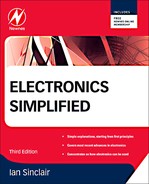Chapter 1. Electricity, Waves, and Pulses
Definition of electrical engineering. Nature of electricity due to charged particles. The fundamental quantities of voltage and current. Effects of electrical charge. Units of measurement. Steady (DC) and alternating (AC) voltages. Sources of steady voltage such as batteries (cells) and dynamos. Sources of alternating voltage such as alternators and electronic circuits. Resistance and Ohm's Law. Power measurement and calculation for simple DC circuits. Electronics as control of electrons and other charged particles. Electromagnetic waves in space. Frequency of waves. Waveforms as shapes of voltage plotted against time. The sinewave. Pulses and effects of circuits that change pulse shapes. Differentiation and integration. Analog and digital circuits.
Fundamental Electricity
Definition
Electrical engineering is the study of generation of electrical power from other forms of power (mainly heat, but now including mechanical systems such as wave and wind), its transmission from one place to another, and its use, both industrial and domestic. Electronics is the branch of electrical engineering concerned with the control of individual particles called electrons whose movements we call electric current.
Electrical engineering is concerned with making use of electricity as a way of transmitting and using power. There are natural sources of electrical power, such as lightning and some living creatures, such as the electric eel, but the main concern of electrical engineering is directed to man-made systems that generate, distribute, and use electricity. Our main uses of electricity depend on converting electrical power to other forms, mainly into mechanical effort, heat and light. These other forms are also our main sources of electrical power.
The first electrical effects to be discovered were those of
static electricity, observed when amber was rubbed with silk. The ancient Greeks first discovered these effects, and because amber is called
electron in Greek, we have coined the words such as
electricity and
electronics that are so familiar today. Considerably later, in the eighteenth century, experimenters discovered other effects that also seemed to be electrical, but these were entirely different. Typically, these effects use a chemical action to generate what we now call electric current in a closed path that we call a
circuit. As an aid to imagining what was happening, electric current can be compared to the flow of water in pipes.
Definition
Definition
Electric current is the flow of electricity through a metal such as a cable. Electric voltage is the electrical form of pressure that forces the current to flow.
Think for a moment about a water circuit, such as is used in central heating. The path for the water is closed (Figure 1.1) and the water is moved by using a pump. No water is lost from the circuit and none is added. Turning off a tap at the tank (breaking the circuit) would make the water level rise, because of the pressure of the pump, in the vertical (overflow) piece of pipe. The pump maintains the pressure that makes the water move, and we can use this movement to transmit power because the flowing water can turn a turbine wheel at some other part of the circuit. Hydraulic machines depend on this idea of a liquid in a circuit, though the modern development of hydraulics came later than our use of electricity.
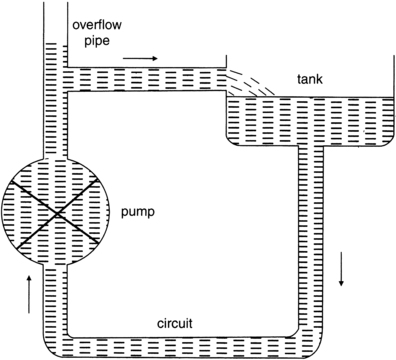 |
| Figure 1.1 A water circuit, which behaves in many ways like an electrical circuit |
It is not surprising, then, that early experimenters thought that electricity was some kind of invisible liquid. Static electricity effects were explained as being caused by the pressure of this liquid, and current electricity by the flow of the liquid. Electrical engineering is mainly concerned with flow, but the later science of electronics has been based as much on static electricity as on current flow, because we now know much more about what is flowing and why it can flow so easily in metal wires. The fundamental quantity of electricity is electrical charge, and that is what moves in a circuit.
Summary
Definition
Summary
Electrical effects were once thought to be caused by an invisible liquid that could flow through metals and accumulate on non-metallic materials. Electrical engineering is concerned with the effects of electrical flow, and most of our early applications of electricity have used the effects of flowing electricity.
Definition
All of the effects we call electrical are due to
electric charge.
Electrostatic (static electricity) effects are caused by charge at rest, and
electric current effects (including magnetism) are caused by charge that is moving.
That definition does not tell you much unless you know something about electric charge. No-one knows precisely what charge
is (though we are slowly getting there), but we do know a lot about what charge
does, and what we know about what charge does is knowledge that has been accumulated since the time of the ancient Greeks. We can summarize what charge does (the
properties of charge):
What we know about the way that charge behaves has led to finding out more about what it is, and we know now that charge is one of the most important effects in the Universe. Like gravity, charge is a way of distorting space, so that it appears to cause force effects at a distance from the cause of the charge. What we call charge is the effect of splitting atoms, separating small particles called
electrons from the rest of each atom. Each electron is negatively charged, and the amount of charge is the same for each electron. The other main part of an atom, the
nucleus, carries exactly as much positive charge as the electrons around it carry negative charge (Figure 1.2), if we picture the atom as looking like the sun and its planets. For example, if there are six electrons then the nucleus must carry six units of positive charge, exactly balancing the total negative charge on the electrons.
Note
• When you rub two non-metallic objects together they will both usually become charged.
• These charges are of two opposite types, one called positive, the other called negative.
• Two charges of the same type (two positives or two negatives) repel each other; two opposite charges (one positive, one negative) attract each other.
• The natural state of any substance is not to have any detectable charge, because it contains equal quantities of positive and negative charges.
Note
Modern physics has long abandoned pictures of atoms as sun-and-planet systems, but this type of picture of the unimaginable is good enough for all purposes concerned with electrical engineering, and for most concerned with electronics.
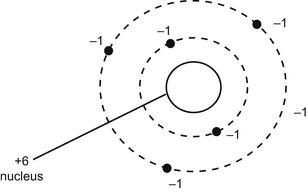 |
| Figure 1.2 A sun-and-planet view of an atom. Though as a concept this is out of date it helps to illustrate the idea of electrons whose total charge balances the charge of the nucleus and also the idea that the outermost electrons can be detached |
When an electron has become separated from the atom that it belongs to, the attraction between the electron and its atom is, for such tiny particles, enormous, and all the effects that we lump together as electricity, ranging from lightning to batteries, are caused by these force effects of charge. The forces between charges that are at rest are responsible for the effects that used to be called static electricity (or
electrostatics), and these effects are important because they are used in several types of electronics devices.
Note
Note
The forces are so enormous that we can usually separate only one electron from a nucleus, and we can separate all of the electrons only at enormous temperatures, such as we find within the sun or in an exploding hydrogen bomb (which is what the sun actually is).
Another option for an electron that has become separated from an atom is to find another atom that has lost its electron (and is therefore positively charged). The movement of electrons from one atom to another causes a large number of measurable effects such as electric current, magnetism, and chemical actions like electroplating. Of these, the most important for electronics purposes are electric current, and one of its effects, magnetism. Materials that allow electrons to move through them are called
conductors; materials that do not allow electrons to move easily through them are called
insulators.
Note
Note
In some types of crystals, compressing the crystal will separate charges, generating a high voltage. These crystals are termed
piezoelectric, and a typical application is as an ignition device for a gas fire or cooker. The effect is also reversible, so that a piezoelectric crystal can be used to convert an electrical pulse into a mechanical compression or expansion of the crystal. This effect is used in ultrasonic cleaners.
The movement of electrons that we call electric current takes place in a circuit, a closed path for electrons that has been created using conducting material. All circuits for current are closed circuits, meaning that electrons will move from a generator through the circuit and back to the generator again. This is essential because unless electrons moved in a closed path like this many atoms would be left without electrons, and that condition could not exist for long because of the large forces that draw the electrons back to the atoms.
Definition
Definition
Electric current is the amount of charge that passes per second any point in a circuit. Electric
voltage is the amount of work that each charge can do when it moves.
These are formal definitions. We cannot easily count the number of electrons that carry charge along a wire, and we cannot easily measure how much work is done when a charge moves. We can, however, measure these quantities by making use of the effects that they cause. Current along a wire, for example, will cause a force on a magnet, and we can measure that force. The voltage caused by some separated charges can be measured by the amount of current that will flow when the charges are allowed to move. The unit of current is called an
ampere or
amp, and the unit of voltage is a
volt. These terms come from the names of the pioneers Ampere and Volta, and the abbreviations are A and V, respectively.
Note
Note
We can create less formal definitions for ourselves. Voltage is like a propelling force for current, and current itself can be thought of as like the current of a river. If we continue with this idea, voltage corresponds to the height of the spring where the river starts.
All substances contain electrons, which we can think of as being the outer layer of each atom. Some materials are made out of atoms that hold their electrons tightly, and when electrons are moved out of place it is not easy for them to return to their positions. In addition, other electrons cannot move from their own atoms to take up empty places on other atoms. We call these materials
insulators, and they are used to prevent electric current from flowing. In addition, insulators can be charged and will remain charged for some time.
A good example is the party balloon which is charged by rubbing it against a woolen sweater and which will cling to the wall or the ceiling until its charge is neutralized. Surprisingly high voltages can be generated in this way on insulators, typically several kilovolts (kV), where kilo means one-thousand. For example, 5
kV means five-thousand volts. A very small current can discharge such materials, and we use the units microamp (μA), meaning a millionth of an amp, nanoamp (nA), meaning a thousandth of a millionth of an amp, and picoamp (pA), meaning a millionth of a millionth of an amp. There is an even smaller unit, the femtoamp (fA), one-thousandth of a picoamp.
Note
Note
As a comparison, the electrical supply to a house in the UK is at 240
V
±
10%, 50 Hz and currents of 1 A to 13 A are used in domestic equipment (though electric cookers can use up to 30 A). In the USA, the minimum supply voltage is 110V to 115V, and the maximum is 120V to 125V, at 60 Hz, with higher currents (requiring thicker wiring).
Now let's look at electricity with lower voltages and higher currents. This is the form of electricity that we are most familiar with and which we use daily.
Steady Voltage
There are several ways of generating a steady voltage, but only two are important for everyday purposes. Batteries are the most familiar method, and the invention of the first battery by Alessandro Volta in 1799 made it possible for the first time to study comparatively large electric currents at voltage levels from 3
V to several hundred volts. A battery is, strictly speaking, a stack of
cells, with each cell (Figure 1.3) converting chemical action into electrical voltage. In the course of this, a metal is dissolved into a metal-salt, releasing energy in the form of electrical voltage that can make current flow.
Note
Note
If the released energy were not converted into electrical form it would be converted to heat, which is what most chemical changes provide. As it is, if you take a large current from a battery you will find that it gets hot.
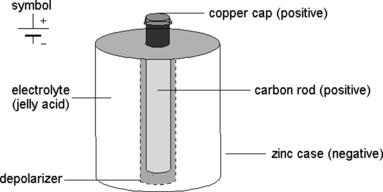 |
| Figure 1.3 A typical cell, the familiar zinc–carbon type. The voltage output is 1.5
V for a fresh cell, and the current that can be drawn depends on the size of the cell, up to a few amperes. The electrical energy is obtained at the expense of chemical energy. The acid dissolves the zinc case, releasing electrons so that the case is negative. The charge accumulates on the carbon rod. The depolarizer removes hydrogen gas which otherwise acts as an insulator |
For centuries the zinc–carbon type of cell, and a few others, were the only types known, but in the later twentieth century several other types were discovered. One of these, the lithium-ion (often abbreviated to
L-ion), is totally different in construction and delivers more than 3
V, unlike other types that provide a maximum of 1.5
V. Just to confuse matters, there is also a lithium cell (
not lithium-ion) that provides just 1.5
V but has a much longer useful life than the older types.
Some types of cell, such as Li-ion and nickel–metal hydride (NiMH), are rechargeable, so that you can connect them to a (higher) voltage and convert the metal-salt back to the metal – but you need to use more energy than you got out of the cell. As always, no energy is ever created. If anyone ever tries to sell you a motor that runs on air, magnetism, or moonbeams, always ask where the energy comes from (usually it is from the people who have been cheated along the way). You can always detect a charlatan by the way that he or she uses spoof-science phrases like
tapping into our natural energy field (and they usually bring crystals into their vaporings as well).
Another way of generating a steady voltage was discovered by Michael Faraday in 1817. He demonstrated the first
dynamo, which worked by rotating a metal disk between the poles of a magnet, using the energy of whatever was turning the disk (Faraday's hand first of all, and later a steam engine) converted into electrical voltage that could provide current (Figure 1.4). Strictly speaking, a voltage that is the result of a generator or a battery should be called an electromotive force (EMF), but this name is slightly old-fashioned nowadays.
Note
Note
Later, Faraday found that higher voltages could be generated by substituting a coil of wire for a metal disk, and this is the basis for modern generators, though the original Faraday principle (the
homopolar dynamo) is still in use for specialized applications.
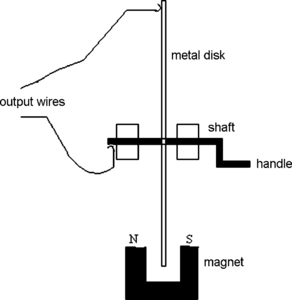 |
| Figure 1.4 Faraday's first electrical generator. When the disk is spun, a voltage (EMF) appears between the contact points or brushes. The voltage is very small, but the principle can be applied to make a dynamo |
In these pioneering days, steady (or
direct) voltage was the only type that was thought to be useful. A steady voltage will cause a steady current to flow when there is a path of conducting material, a
circuit, between the points where the voltage (the EMF) exists. We call these points
terminals. A cell or a simple dynamo will have two terminals, one that we call
positive and the other
negative. When a wire, or any other conductor, is used to connect the terminals, a current will flow, and if the voltage is steady, then the current also will be steady. That does not mean that it will be steady for ever. A cell will be exhausted when its metal is all dissolved, and the voltage will fall to zero. A dynamo will generate a voltage only for as long as the shaft is turned. By convention, we say that the current flows from the positive terminal to the negative terminal (even though we know now that the electrons move in the opposite direction).
A steady voltage will cause a steady current, called direct current (
DC), to flow, and in 1826 Georg Simeon Ohm found what determined how much current would flow. He called this quantity
resistance. The three quantities, voltage, current, and resistance, are therefore related, and the unit of resistance is called the
ohm in his honor. For any part of a circuit, we can measure the voltage across the circuit (between one end and the other) and the current through the circuit and so find the resistance.
Definition
Note
Definition
When a current of
I amps flows, using a voltage of
V tubevolts, then the resistance
R ohms is equal to voltage divided by current. In symbols, this is
R=
V/
I, and we can write this also as
V=
RI or
I=
V/
R.
Note
This relationship is often, wrongly, called
Ohm's law. The correct definition of Ohm's law states that this quantity called resistance is constant for a metal that is used to conduct current at a steady temperature. What this boils down to is that we can use the relationship in any of its three forms with
R constant if the resistance
R is of a metal at constant temperature. In other words, if 6
V causes 2
A to flow through a resistance, then 12
V will cause 4 A to flow through the same piece of metal (whose resistance is 3 ohms, written as 3
Ω. This is not true when some non-metal materials are used, or if a metal is allowed to get hot. For example, the current through a semiconductor obeysI=
V/
R, but the value of
R is not constant, it changes for each value of current. Similarly, a torch bulb has a much higher resistance when it is hot than it has when it is cold. We cannot use Ohm's law assuming a constant value of resistance for these examples.
We can determine whether or not a conducting material obeys Ohm's law by plotting a graph of current against voltage, using a circuit as in Figure 1.5(a). If this results in a graph that is a straight line (Figure 1.5b), then the material obeys Ohm's law; it is
ohmic. Most metals behave like this if their temperature is kept constant. If the graph is curved (Figure 1.5c) the material is not ohmic, and this type of behavior is found when metals change temperature considerably or when we use semiconducting materials in the circuit.
 |
| Figure 1.5 Voltage, current and resistance. (a) The voltage (EMF) of a cell is used to pass current through a sample of conducting material: the ratio of voltage across the sample to current through the sample defines the resistance; (b) ohmic graph; (c) one form of non-ohmic graph |
Power
Power is the
rate of doing work, meaning the amount of work done per second. When we use electricity, perhaps for heating, lighting, running a motor, or plating gold on to a base metal, we are making use of power, converting it from the electrical form to other forms. The amount of power that is dissipated or converted can be calculated easily for anything that uses steady voltage and current; it is equal to the figure of volts multiplied by the figure of current. When this power is converted into heat we often call it
dissipation because we cannot contain it; it leaks away. The calculation of power, in symbols, is:
 where
V is in volts and
I is in amps. The unit of power is the watt, abbreviation W. As an example, if the torch bulb is rated at 3
V 0.5
A then its power is 1.5
W.
where
V is in volts and
I is in amps. The unit of power is the watt, abbreviation W. As an example, if the torch bulb is rated at 3
V 0.5
A then its power is 1.5
W.
Things are not so simple when we are working with quantities that are not steady, but we can always find the amount of power by making measurements of volts and amps and carrying out a multiplication. The difference is that for changing voltages and currents we need to multiply by another factor as well; we will look at that later when we deal with RMS quantities and phase angles.
Alternating Voltage
The voltage (EMF) that is generated by a cell or battery is truly steady, but the voltage from a rotating generator is not. When one side of the revolving coil of wire is approaching a pole of the magnet, the changing voltage is in one direction, but as the wire moves away from the magnetic pole, the changing voltage is in the other direction. Because there are two poles to a magnet, the voltage from a rotating coil rises and falls twice in a revolution, positive for half the time and negative for the other half. This is an
alternating voltage, alternately in one direction and then the other direction. The graph looks like that of Figure 1.6 and the time it takes to go through one complete cycle of the waveshape is the time that it takes to turn the coil through a complete revolution. The snake shape of the graph gives rise to the name
sinewave, from the Latin word for ‘snake’.
 |
| Figure 1.6 A sinewave that can be produced by rotating a coil between the poles of a magnet. This is the form of AC wave used for electrical supplies and also for radio carrier waves (see later). Radio carrier waves are generated by circuits called oscillators rather than by rotating machines |
Faraday's later type of dynamo got around this reversal of current by using a mechanical switch called a
commutator, which reversed the connections to the coil twice on each revolution, just as the voltage passed through zero (Figure 1.7). This generated an
EMF which, though not exactly steady, was at least always in the same direction, so that it was possible to label one terminal as plus and the other as minus. If the shaft of the dynamo is spun quickly enough, there is in practice very little difference between the voltage from the dynamo and the same amount of voltage from a battery. For tasks like heating, lighting, electroplating, battery charging, and so on, the supplies are equivalent.
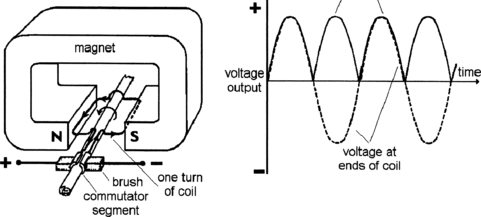 |
| Figure 1.7 Principle of the dynamo. The coil generates a voltage that is alternating, but by reversing the connections on each half turn, the output voltage is in one direction (a unidirectional voltage). Modern dynamos use slip-rings and semiconductor circuits (see Figure 2.18) rather than the old-fashioned commutator (which wears out because of sparking and mechanical rubbing) |
There are other ways of generating electricity from heat and from light, but they suffer the problems of inefficient conversion (not much electrical energy out for a lot of heat energy in) or low density of energy (for example, you have to cover a lot of ground with light cells to generate electricity for a house). A few small generators use nuclear power directly, by collecting the electrons that radioactive materials give out, but large-scale nuclear reactors use the heat of the reaction to generate steam and supply it to turbines. These are therefore steam-powered generators, and the only difference is in how the steam is obtained (and the hysteria that is generated).
The same is true of the places on Earth where steam can be obtained from holes in the ground, providing geothermal power, but this steam-power is less controllable and certainly not available everywhere. Higher efficiency figures can be obtained where heat is not involved, such as in hydroelectric generators. Wind turbines, in contrast, require the variable voltage that they generate to be turned into a constant voltage and frequency (see later) and these conversions reduce the already low efficiency. If we were really serious about spending money wisely we would try to develop tidal or wave generators that would serve the additional function of protecting our coasts from erosion.
Note
Summary
Note
Incidentally, we could count electricity generated by solar heating as nuclear, because the Sun, like other stars, is a gigantic nuclear furnace. The difference is that you do not (yet) get demonstrators demanding that the Sun should be shut down or moved. Unlike chemical energy, electricity cannot be stored in any useful quantity so we have to generate as much as we use.
Summary
Voltage (EMF) can be generated by converting energy (mechanical, chemical, or heat energy) into electrical form. A cell converts chemical energy into a steady voltage, but only for as long as there is metal to supply the energy. A dynamo uses mechanical energy and will generate a voltage for as long as the shaft can be turned by a steam engine, wind-power, a waterwheel, or whatever source of energy is at hand. The output of a dynamo is not steady, but is in one direction and can be used for the same purposes as truly steady voltage.
Alternating Current and Waves
If we omit the commutator of a dynamo and connect to the ends of the coil rotating at a steady number of revolutions per second, the graph of the voltage, plotted against time, shows a shape that is a sinewave, as was illustrated in Figure 1.6. The connection to the coil can be made using slip-rings (Figure 1.8), so as to avoid twisting the connecting wires. This voltage is analternating voltage and when we use an alternating voltage in a circuit, the current that flows is
alternating current (
AC). A graph of current plotted against time is of the same shape as the graph of voltage, and the peak of current is at exactly the same time as the peak of voltage in each direction if the circuit contains only resistances.
Note
Note
In practice, the rotating portion is usually a magnet that uses current in a coil (an
electromagnet), and the slip-rings carry the steady current that magnetizes this rotor. The output is taken from a coil wound on the non-rotating portion (stator), so that the much larger output current does not have to be passed through a brush and slip-rings. This device is called an
alternator, and its most familiar form is the generator in your car. The AC output from the alternator is converted into DC to charge the battery.
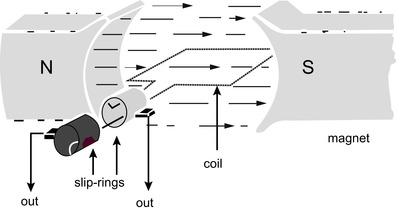 |
| Figure 1.8 Slip-rings provide a way of connecting wires to each end of a rotating coil |
We can use AC for electrical heating, for electric light, for motors, and in fact for most domestic uses of electricity. It cannot be used for electroplating or battery charging, however, and it cannot be used for most types of electronic equipment. In the nineteenth century, when electronics was in its infancy, the advantages of AC greatly outweighed any minor disadvantages, particularly since AC could be converted to DC if DC were essential. What are the advantages of using AC?
• AC is the natural output from a rotating generator, requiring no commutators or other reversing devices.
• Alternating voltage can be converted up or down (using a
transformer; see later) without using any mechanical actions. For example, if you generate at 5
kV you can convert this up to 100
kV or down to 240
V with negligible losses. The higher the voltage you convert to, the longer the distance you can connect by a cable of reasonable size. This makes the National Grid possible, so that generating stations need not be close to users of electricity.
• Very simple motors can be made that use AC and which will run at a constant speed (used for clocks, gramophone motors, and tape-recorder motors).
• AC can be used to power vibrating motors, such as used for electric shavers.
• AC can be converted to DC for electronic equipment, and can be used to provide several different steady voltage levels from one AC supply.
Virtually every country in the world therefore generates and distributes electricity as AC, and the convention is to use a rate of 50 cycles per second (50 hertz or Hz) in Europe or 60 cycles per second (60
Hz) in the USA. In terms of a simple generator, this corresponds to spinning the shaft of the generator at 3000 revolutions per minute (r.p.m.) for 50
Hz, or 3600 r.p.m. for 60
Hz. The abbreviation Hz is for hertz, the unit of one cycle of alternation per second. This was named after Heinrich Hertz, who discovered radio waves in 1884.
Note
Summary
Note
Most of Europe uses AC at 240
V, 50
Hz, but US domestic appliances need thicker cables than their European counterparts (for the same amount of power) because a higher current is needed to provide the same power at the lower voltage.
Summary
DC is the natural output of a battery, but AC is the natural output of a rotating generator. AC is used worldwide for generating and distributing electricity, mainly because it makes it possible to have a large distance between the generator and the user. Since AC can be converted to DC much more easily than converting DC to AC, there are no problems in using an AC supply for electronics circuits that require a steady voltage supply.
Electronics
Definition
Electronics is a branch of electrical engineering that is concerned with controlling charged particles such as electrons and holes. We will introduce the idea of
holes now.
Atoms such as those of metals can be so tightly packed together that they can share electrons, and the loss of an electron from a set of these packed atoms does not cause such a large upset in any one atom. In these materials, electric current can flow by shifting electrons from one set of atoms to the next. We call these materials
conductors. All metals contain closely packed atoms, and so all metals are conductors, some much better than others. A small voltage, perhaps 1.5
V, 6
V, 12
V or so, can push electrons through a piece of metal, and large currents can flow. These currents might be of several amps, or for very low voltages perhaps smaller amounts (see earlier) measured in milliamps (mA), microamps (μA), picoamps (pA), or even femtoamps.
Note
Note
Pure liquids, other than liquid metals such as mercury or gallium, are not good conductors, but liquids with dissolved salts will conduct because when a salt dissolves in water (for example), the solid salt is split into charged particles called
ions. These ions can move, so that the solution will conduct electricity. Note that the word ‘salt’ means any compound made by combining a metal and a non-metal, of which common salt (sodium chloride) is the most familiar example.
As well as being closely packed, the atoms of a metal are usually arranged in a pattern, a
crystal. These patterns often contain gaps in the electron arrangement, called
holes, and these holes can also move from one part of the crystal to another (though they cannot exist beyond the crystal). Because a hole in a crystal behaves like a positive charge, movement of holes also amounts to electric current, and in most metals when electric current flows, part of the current is due to hole movement and the rest to electron movement.
There are some materials for which the relative amount of electrons and holes can be adjusted. The materials we call
semiconductors (typically silicon) can have tiny amounts of other materials added to the pure metal crystals during the refining process; this action is called
doping. The result is that we can create a material that conducts mainly by hole movement (a P-type semiconductor) or one that conducts mainly by electron movement (an N-type semiconductor). In addition, the number of particles that are free to move (free particles) is less than in a metal, so that the movement of the particles is faster (for the same amount of current) than it is in metals, and the movement can be affected by the presence of charges (which attract or repel the electrons or holes and so interfere with movement). The movement can also be affected by magnets. Semiconductors are important because they allow us to control the movement of electrons and holes in crystals.
Summary
Note
Summary
• All materials can be charged, for example by dislodging electrons. For every positively charged material there is a negatively charged material, because charging is caused by separating electrons from atoms, and the electrons will eventually return.
• The movement of electrons is what we detect as electric current, and the ‘pushing force’ for the current, caused by the attraction between positive and negative, is called voltage.
• Voltage is the cause of current.
• Materials can be roughly classed as conductors or insulators. Conductors have closely packed atoms which can share electrons, so that electron movement is easy, and electric current can flow even with only a small voltage. Insulators have more separation between atoms, electrons are not shared, and even a very high voltage will not cause any detectable current to flow. When we work with conductors we use low voltage levels and comparatively high currents. When we work with insulators we can use high voltage levels and very low currents.
• The third class of material is the semiconductor. Semiconductors can be natural, but better results are obtained by refining materials and deliberately adding impurities that will alter the number of free electrons or holes. The importance of semiconductors is that they make it possible to control the flow of charged particles, and this is the whole basis of modern electronics.
Note
Before semiconductors were discovered, electronic vacuum tubes (called
valves in the UK) were used to control electron (not hole) flow. The principle, dating from about 1904, is that when electrons move in a vacuum, their movement through a wire gauze (or grid) can be controlled by altering the voltage on the grid. Vacuum tubes are still used where large voltages and currents have to be controlled, such as for high-power radio transmitters, and also for cathode ray tubes (for older television receivers and for the measuring instruments called oscilloscopes), but their use for other purposes has died out. Even the oscilloscope requirement is now being replaced.
Electromagnetic Waves
AC would be important enough even if it only provided a way to generate and distribute electrical power, but it has even greater importance. A hint of this came in 1873 when James Clerk Maxwell published a book containing equations that showed that an alternating voltage could generate waves of voltage and magnetism in space, and that these waves would travel at the same speed as light. He called these waves electromagnetic waves, and from there it was a short step to show that light was just one of these waves.
Why just one? These waves differ from each other in two ways. One is the number of waves that pass a fixed point per second, called the
frequency of the waves. The other is the
amplitude (the amount of rise and fall in each wave) (Figure 1.9). Amplitude determines the energy of the wave, so that a large amplitude of a light wave means a bright light. Frequency affects how easily a wave is launched into space and how we detect it.
Definition
Note
Definition
Low-frequency electromagnetic waves are called
radio waves, and we generate them and detect them nowadays using electronic methods. To put figures to these quantities, waves with frequencies below 100
kHz (one-hundred-thousand complete cycles per second) are classed as very low frequency (VLF) and are used mainly for time signals and for some long-distance communications. Waves of around 1
MHz (one-million hertz) frequency are called medium-wave, and a large number of entertainment radio transmitters use this range. Waves in the range 10
MHz to around 50
MHz are classed as short waves, used for communications, and the very high-frequency (VHF) range 50
MHz to 200
MHz is also used for similar purposes. As the frequency is increased, the range of useful communications along the Earth's surface decreases, but the range in space (as from a satellite to Earth) is much greater.
Note
The amplitude that is quoted for a wave is usually the peak amplitude. The figure of peak-to-peak amplitude is used when the wave is not symmetrical.
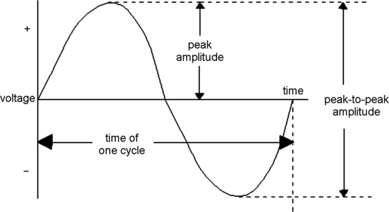 |
| Figure 1.9 Amplitude. The peak amplitude figure is used for symmetrical waves, like sinewaves. Peak-to-peak readings are used for waves whose shape is not symmetrical |
The range from 300
MHz to 1000
MHz is ultra-high frequency (UHF), used for television transmissions, and once we get to using the unit of GHz (1 gigahertz is equal to 1000
MHz) then the signals are in the
microwave ranges, used for mobile phones, satellite communications, and radar. These names are only rough indications of a range, and because we have found it necessary to use higher and higher frequencies over the years we have had to invent names for new ranges of frequencies that we once thought were unusable.
Note
Note
Of all the possible microwave frequencies, only one (2.45
GHz) has a strong heating effect on anything that contains water. Other frequencies, such as are used for mobile phones and other communications (including satellite broadcasting), cause only negligible heating effects on materials unless very high powers are used.
One lower frequency range is particularly significant to us, and is called the
audio range. This is the range of frequencies between about 30
Hz and 20
kHz, and its significance is that this is the range of frequencies of sound waves that we can hear (bats might have a different definition). A microphone, for example, used in a concert hall would provide an electrical output that would consist of waves in this range. For speech, we make use of a much smaller range, about 100–400
Hz.
Note
Note
A
microphone is an example of an important device called a
transducer. A transducer converts one form of energy to another, and for electronics purposes, the important transducers are those that have an input or an output which is electrical, particularly if that input or output is in the form of a wave. For audio waves, the output transducer (converting electrical waves into sound waves) is a
loudspeaker.
All the electronic methods that we know for generating waves are subject to some limitation at the highest frequencies, and methods other than electronic methods of generating and detecting waves have to be used. At around 1000
GHz, the waves are called
infrared, and their effect on us (and any other objects) is a heating effect on all materials that absorb the waves, so that we can detect these waves coming from any warm object. We can also use electronic transducers to convert infrared signals into electrical signals. Higher frequencies, to about 100,000
GHz, correspond to the infrared radiation from red-hot objects, and one small range of frequencies between 100,000 and 1,000,000
GHz is what we call
light. Higher still we have X-rays, gamma rays and others which we find very difficult to detect and cannot generate for ourselves.
As far as electronics is concerned, we make most use of the waves in the range from a few hertz to several tens of gigahertz, and radio technology is concerned with how these waves are generated, used to carry information, launched, and detected. Radio, in this respect, includes television and cellular telephones, because the use of the waves is the same; only the information is different.
Waveforms
The waveform of a wave is its shape, and because an electromagnetic wave is invisible the shape we refer to is the shape of the graph of (usually) voltage plotted against time. The instrument called the oscilloscope (see Chapter 17) will display waveforms; we do not need to draw graphs from voltage and time readings. We are seldom particularly interested in the shape of the waves that are transmitted through space, and waveforms are of interest mainly for waves that are transmitted along wires and other conductors in electronic circuits.
The simplest type of waveform is the shape of the wave that is generated by the magnet and coil arrangement that Faraday used (which was illustrated in Figure 1.6). The shape that this generates is called a
sinewave (or sine wave) and it is the same shape as a graph of the sine of an angle plotted against the angle. What makes the sinewave particularly important is that any other shape of wave can be created by mixing sinewaves of different frequencies, and any shape of wave can be analyzed in terms of a mixture of sinewaves.
Though a pure sinewave is the simplest wave, its uses are confined to AC power generation and to radio transmitters. Most of the waves that we use in electronics are a long way from a sinewave shape, and one special type, the
pulse, has become particularly important from the second half of the twentieth century onwards.
Take a look at the two shapes in Figure 1.10. Wave (a) is called a
square wave, for obvious reasons, and it is used particularly when a wave is used for precise timing. Because the edges of the wave are sharp, each can be used for starting or stopping an action. If you used a sinewave there would be some uncertainty about where to start or stop, but the steep edge of the square wave makes the timing action much more certain. For example, the time needed to change the voltage level of such a wave might be only 50 nanoseconds or less (1 nanosecond is a thousandth of a millionth of a second).
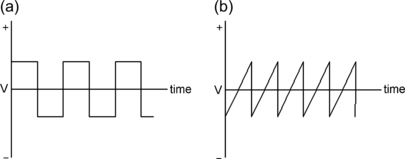 |
| Figure 1.10 Other waveforms: (a) square waves; (b) sawtooth or sweep waveform |
The square wave is nothing like a sinewave, and it can be generated naturally by switching a steady voltage on and off rather than by any type of rotating generator. Very precise square waves are generated by electronic circuits that use a vibrating quartz crystal to control the frequency, and these circuits are used in clocks and watches. Even greater precision is obtained from the
atomic clock that uses the natural vibration of atoms as a fixed frequency.
The other wave, in Figure 1.10(b), is called a
sweep in the USA or a
sawtooth in the UK. It features a long, even, rise (or fall) followed by a fast return to the starting voltage. Before 1936, a wave of this shape would have been an academic curiosity, but this is the shape of wave that is needed for a cathode ray tube, for television, or for radar, and we will look at it again in Chapter 8 and Chapter 17. The sawtooth is also an important waveform that is used in electronic measuring instruments.
What marks these waves out as totally different from the sinewave is that they show very sharp changes of voltage. A sinewave never changes abruptly; its rate of change is fixed by its frequency and amplitude. These square and sawtooth waves can change in a time that bears no relation to the frequency or the amplitude. A square wave might have a frequency of only 1
Hz, but change voltage in less than one-millionth of a second (a microsecond, written as 1
μs).
Summary
Summary
The waveform is the shape of an electrical wave, and the most fundamental waveform is the sinewave that is generated by a coil rotating between the poles of a magnet. The important features of a waveform are its frequency, the number of times a wave repeats per second, and its amplitude, the height of the wave. Sinewaves are used mainly in radio applications, but other waveshapes such as square and sawtooth waves are used, particularly where timing is important.
Pulses
The pulse is a waveform, but one that you might not recognize as a wave because the time of the pulse is very short compared to the time between pulses. Figure 1.11 illustrates three different pulse shapes, all of which share a very sharply rising portion, the
leading edge. For a negative pulse, this leading edge would be a sharp fall in voltage.
Definition
Definition
A pulse is a rapid change in voltage which is of very short duration compared with the time between pulses.
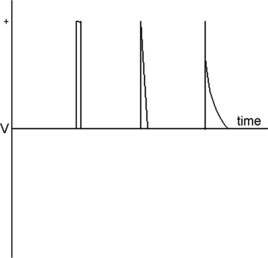 |
| Figure 1.11 Examples of pulse waveforms. The common factor is a sharp leading edge |
For example, a pulse might repeat at a rate of 1
kHz, 1000 pulses per second. The actual pulse might have a duration, a pulse time, of only 10
μs, so that the change in voltage lasts only for 10
μs in the 1
ms (millisecond) between pulses. That makes the time of the pulse (its
duty cycle) 1/100 of the time between pulses, and these are fairly typical figures. Pulses are used for timing, and they have the advantage that they use very little energy because the change in voltage is so short. A pulse can be used to start an action, to stop an action, or to maintain an action (such as keeping a wave in step, synchronized, with the pulses).
Modern digital electronics systems, particularly computers, rely heavily on the use of pulses, and when we work on these systems we are not greatly concerned about waveshapes, only about pulse
timing. There are many things that can change a waveshape, making it very difficult to preserve the shape of a wave. By contrast, it is more difficult to upset pulse timing by any natural means, so that circuits which depend on pulse timing are more reliable in this respect than circuits that depend on waveshapes.
The classic example is sound recording. Hi-fi systems in the past tried to work with a waveform that had a very small amplitude (the output from a gramophone pickup) and keep the shape of the waveform in the form of a copy that had a much larger amplitude. This large-scale copy was used to operate loudspeakers, and we called the whole exercise
amplification.
The problem with this system is that a copy of the waveform is never perfect, something that is even more obvious when you make a copy of a copy. Any blemish on the surface of the record, any false movement of the stylus, any interfering signals in the circuits all will make the copied waveform inaccurate, a process we call distortion.
Nowadays the sound is recorded digitally as a set of pulses, using the pulses to represent numbers, and each point in a waveform is represented by a number. Using pulses for counting, we can ensure that the numbers are not changed, so that when the stream of numbers is converted back to a wave, the shape of the wave is exactly the same as was recorded. This is the basis of
compact discs, the most familiar of the digital systems that have over the last few years replaced so many of the electronics methods that we grew up with. There will be more of all that in Chapter 11 and Chapter 12.
Actions on Pulses
There are two actions that can be carried out on pulses and on square-shaped waves that are important for many purposes. One of these is
differentiation, and this can be achieved by passing a pulse or square wave into a circuit that selectively passes only the fast-changing part of the input. Figure 1.12 shows the result of differentiating, which converts the pulse or square wave into a pair of sharp spike shapes. These spikes are very short pulses, and we can use them for timing. We can select either a positive or a negative spike by using other circuits.
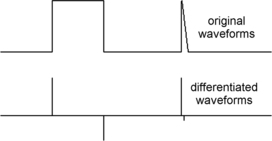 |
| Figure 1.12 Differentiating action, illustrated on two waveforms. The action emphasizes the sharply changing portions of the waves |
The other action is called
integration, and it is a form of averaging or smoothing. A typical action is illustrated in Figure 1.13, showing a set of pulses as the input to an integrating circuit (an integrator). The output is a steady rise in voltage, and eventually this will become steady at a value which is the peak voltage value of the pulses. This is the opposite action to differentiation, removing rapid changes from a waveform.
 |
| Figure 1.13 Integrating action. The action smooths out sharp changes, altering a steep rise into a sloping rise, for example |
There is another waveform that is very important in almost all branches of electronics, the sawtooth or sweep wave. This is obtained by integrating part of a square wave, and was illustrated earlier in Figure 1.10(b). The steady rise (or fall) of voltage is called the sweep portion, and the rapid return (the portion that is not integrated) is called the
flyback. We shall meet this type of wave again in connection with television, oscilloscopes, and digital voltmeters.
Summary
Definition
Summary
Pulse and square waveforms have sharp changes of voltage and can be used for timing. These waveforms can be differentiated or integrated by using suitable circuits. The action of differentiation emphasizes sharp changes in a wave; the opposite action of integration smooths out sharp changes.
Definition
Electronic circuits can be divided into
analog and
digital types. Analog circuits are used to operate on waves, preserving the shape of the wave. Digital circuits work with pulses and the shape is not important, only the timing.
Early applications for electronics required actions such as amplification, the creation of a copy of a wave with larger amplitude. The type of circuits used for these actions are classed as analog circuits. As the twentieth century progressed, circuits that counted using pulses became more important and such circuits are digital circuits. At present, digital circuit methods are steadily replacing the older analog methods, and this progress is reflected in this book.
..................Content has been hidden....................
You can't read the all page of ebook, please click here login for view all page.
